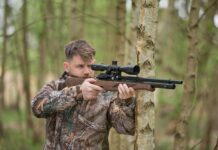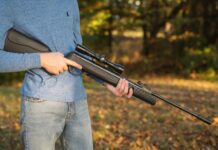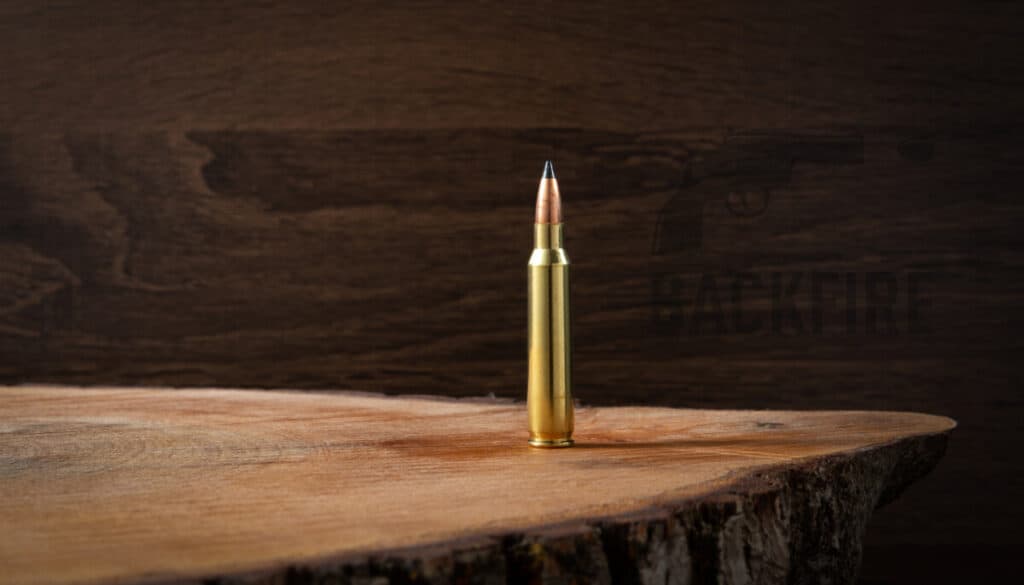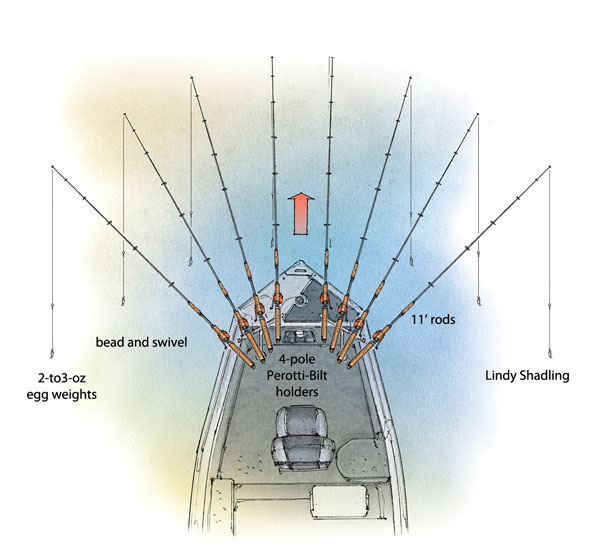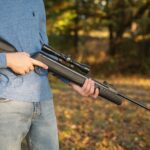This article contains affiliate links. We may earn a small commission if you purchase via these links.
If this is your budget, you need to do some serious digging before handing over any cash.
$500 is still a hefty chunk of change, but with brands like Vortex, Leupold, Vanguard, and Bushnell, you’ve got variety and quality on your side.
Let’s take a look and see which brand has the best spotting scope under $500.
Table of Contents
Top Spotting Scopes Under $500 (Comparison)
When it comes to spotting scopes, often manufacturers either do it well or they don’t. Many of our top brands that are hunters’ go-to companies had some disappointing hits and misses – mostly misses – in this price range.
Because of this, when putting together the line-up for the $300-500 price range, it was tough to come up with the top three. So, you’ll have to forgive us if we throw in an option that slightly bends the rules – it’s just going to have to do.
We took into account the grade quality of the glass, any special coatings, and ability to see groupings clearly in the 200-400 yard range. Let’s take a look at what we came up with.
The 6 Best Spotting Scopes Under $500
1. Leupold SX-2 Alpine 20-60×80 – Best Overall
The SX-2 Alpine spotting scope is capable of providing clear and sharp resolution throughout all hours of the day and across its entire magnification range. It has a drawback or two, but it’s easily one of the best spotting scopes for its price point.
Pros:
- HD Optics
- Oversized eyepiece
- Rugged construction
- Fog/waterproof
- Lifetime guarantee
Cons:
- ED glass confusion
The SX-2 Alpine has Leupold’s Advanced Optical System with HD quality. Leupold lacks mentioning any ED elements, but the glass was made with calcium-fluoride (much like ED glass, right?) that helps to reduce the dispersion of lightwaves at the objective lens. So yes, while there will be some chromatic aberration, it might only be visible on the higher powers and in difficult light conditions that most spotting scopes struggle with too.
Helping to keep you longer behind the eyepiece by reducing fatigue and compensating for less-than-perfect eye alignment is the oversized 59.94mm eyepiece and the 19-18mm of eye relief. All-day glassing, big game hunts, and long-range spotting of groupings are tasks the Alpine HD is well suited to.
Build quality is covered with an impressively balanced speed-to-precision helical focus, fogproof and waterproof body, and it’s been tested to perform in extreme climate conditions from -40 to 160-degrees Fahrenheit.
If the name is any indication, you may have to put in for a hunting unit where you can test it to its limit. High mountain hunts for black bears, whitetails, mules, elk, and bighorn sheep are more productive when you have glass that can keep up with the harsh alpine conditions.
2. Athlon Argos HD 20-60×85 – Best Value
The Argos HD mustn’t be compared to more expensive scopes as it’s one of the cheapest in this price range. To get a colossal 85mm spotter for under $400, it’s a budget buy with value.
Pros:
- 85mm aperture
- Advanced FMC coatings
- Helical focus
- Fog/waterproof
- Extendable sunshade
Cons:
- Optical quality vs marketing
It may be harsh to be so blunt about the optical quality of the Argos HD, but the marketing implies that it has a couple things that it, in fact, lacks. It does not have ED glass or additional elements that can be confirmed to provide high-definition optics. Athlon says the scope has “phase coated Porro prisms” but Porro prisms are inherently unaffected by beam splitting that occurs in roof prisms.
The gist of it is, Porro prisms are great at maintaining contrast and resolution and will perform better than roof prisms that lack PC coatings. As such, the Argos does well for its price point with or without the supposed PC coatings. It struggles with light loss past 40x and off-axis sharpness as do all spotting scopes at comparable price points.
Looking past the marketing gumbo, it has laudable resolution in lowlight conditions. It’s adequate for hunting, range use, wildlife observation, and amateur lunar observation.
The adjustable features of the spotter, i.e., magnification ring, multi-position eyecup, and extendable sunshade offer smooth responsiveness. The focus knob is touchy at max power, so for instant gratification for birdwatching when seconds count, the Argos might not work for you. For focusing in long-range in the field or the shooting range, you have time to be light-handed here.
For the average range shooter, causal outdoorsman, and spot and stalk hunter, the Argos offers big specs with better-than-average performance for its price point. Now that’s value.
3. Vortex Diamondback HD 20-60×85 – Best for Hunting
Overall, the Vortex Diamondback HD isn’t perfect, but for the money, it offers a lot more than the old series. The VIP warranty can’t be beat, so there’s no fear in taking it into wild country for the hunt. The bottom line is that it performs, it’s under $500, and it’s highly recommended.
Pros:
- ArmorTek coating
- Dual focus
- Long eye relief
- Argon gas
- Arca-Swiss compatible
Cons:
- Chromatic aberration
The Diamondback HD spotting scopes have an HD Optical System, but Vortex did not disclose any ED elements. It suffers from color fringing and can be distracting for birdwatching and lunar observation/digiscoping.
The optics will not hold a candle to the Viper HD let alone the Razor HD. But as the entry-level spotting scope line, the glass quality is more than acceptably functional for wildlife observation, range use out to 1000 yards, and Western deer hunting.
The Diamondback HD is rubber armored, waterproof, and has been purged with Argon gas that is usually seen in the high-end range. It has long eye relief of 20.3-18.3mm, has an adjustable eyecup and sunshade, and a rotating tripod ring.
A new feature is the dual focus for course and fine adjustments with the helical focus collar. It’s compatible with Arca-Swiss tripods without needing additional plates and can be mounted to standard ¼-20 tripods.
The HD models gained weight and the objective got larger. This model weighs 60.9oz, and it’s not a bad thing. The extra weight will help to stabilize the setup especially when you’re in the high mountains and big country where windy conditions are the norm.
The glass isn’t perfect and that’s okay. You can always spend more to get better, but for this price point, the Diamondback HD is a performer.
4. Vanguard Endeavor HD 82 Scope
Remember how we said we were going to bend the rules a little bit? This is where we show you how. The Endeavor is just above the $500 mark, but when it’s on sale, you can get it within this price range. We had to do a little tweaking because we only want to offer you the most reliable and high-performing spotting scopes there are. There’s no point in recommending a dud.
The Endeavor has a beast of an objective lens that can provide ultimate brightness and light collection. To take maximum advantage of the 82 mm lens, it’s been made with extra-low dispersion glass elements, been fully multi-coated, and has BaK4 prism glass. There’s more yet to spill about the Vanguard Endeavor, so keep your eyes peeled for the full review!
5. Visionking 30-90X100SS Spotting Scope
This spotting scope is huge, so it’s no joke to assume this thing will be the king of faraway vision. With extreme, high magnification and a huge 100 mm aperture, no distance will be out of your reach.
Pros:
- Price
- Extreme high magnification
- Huge aperture
- Dual focus
- Weatherproof
Cons:
- Heavy
If you think you can have these spotting scope specs without some serious poundage, you’re kidding yourself. With almost 6 pounds to tote and set up, this is a beast of an optic that you want to use with a quality tripod that can support its weight.
So, what’s the point of such extreme specs? To see more of course! The 100 mm aperture will allow in as much ambient light as possible throughout different times of the day whether it’s bird and wildlife watching or star gazing. With such high magnification, you’ll want to make use of the 2-speed dual focus dials to get the sharpest and clearest image possible.
The BaK4 prism glass is fully multi-coated, but there’s no mention of any phase/prism coatings or extra-low dispersion glass elements. The lack of these additional glass features is surprising for such a high powered scope, and it may mean clarity might not be the best as it reaches max magnification.
Even for a generic, off-brand spotter, it still covered its bases when it comes to durability. It has RainGuard HD water-repellent lens coating (sound familiar? Bushnell tech?), it’s O-ring sealed, nitrogen-purged, and 100% waterproof.
If you’re the type of spotter that likes to get set up and stay stationary, the Visionking scope will work for you. A tripod is included in the buy so you won’t have to immediately fork out for one.
6. Kowa TSN-601 Angled 60mm Spotting Scope
Kowa, a prestigious Japanese brand known worldwide for their quality optics, and we have a spotting scope that just barely fits this price range. Owning a Kowa for 500 bucks just might be the best bargain deal of the day.
Pros:
- Price
- Interchangeable eyepiece system
- Made in Japan
- Weatherproof
- 10-year warranty
Cons:
- Scope body only
Typically, you won’t see spotting scopes sold by eyepiece and scope body separately until you’re spending over two grand. This is indicative of premium quality to ensure you’re purchasing the most appropriate eyepiece system for your spotting application. Want variety? You can buy and use an eyepiece with a different power range.
With the interchangeable eyepiece system, you also have access to see if Kowa compatible digiscoping accessories can work for photography, recording, and capturing rare once-in-a-lifetime moments that you won’t ever be able to duplicate.
Still, if you’re spending only 500 buckaroos on the scope body, you’ve got to wonder how much it costs to get the eyepiece. Expect to add at least a few hundred bucks to your budget.
The Kowa spotter is made in Japan, and they’re usually an excellent source of glass and quality when it comes to optics. When you buy this scope from an authorized dealership, you’ll get their lifetime warranty on it.
It’s nitrogen-purged and O-ring sealed for both fog and waterproof protection. It’s made with polycarbonate materials to keep weight to a minimum without compromising build quality.
What more is there to say? You’re getting a Kowa for 500 bucks!
What to Look for in a Spotting Scope in This Price Range
Spotting scopes in this price range should have a few premium perks thrown in – we’re talking about $500, it’s got to be worth it. However, you’ve got to be brand-specific to ensure you’re getting the best of what you can afford.
If you’re going with a high-powered and heavy scope, you’re going to want to add additional costs for quality, strong, and solid tripods and mounting systems. Just keep that in mind when you plan on spending every penny. Here’s what else you need to look for.
Glass & Coatings
Overall, we should start to see some ED (Extra-low Dispersion) enter the market. Some spotting scopes might have “HD quality” but it doesn’t guarantee ED elements. When it comes to coatings, we should see FMC and extra lens coating formulas to enhance light transmission and protect the lens.
Magnification & Objective Lens (Configuration)
On average, there will be a lot of 20-60×80 configurations at this price point. Considering the glass quality, this is a good configuration to stay within since more magnification will demand more performance from the glass.
Though most spotting scopes under $500 will have the eyepiece included with the scope, you may see some interchangeable eyepiece scopes available. Though rare to see it at this price point, it can happen.
Eye Relief & FOV
Eye relief will tell you how comfortable the eyepiece will be to use and if you can keep your glasses on or not. I would say that 15 mm is the minimal amount of acceptable eye relief if you wear glasses, but it’s better to have at least 19-20 mm on the long side as it does get shorter at max power.
The field of view can indicate what applications the spotting scope could be good for. Though high magnification narrows the FOV, it can provide close-ups of the target that is good for long-range seeing. On the other hand, a wide FOV is good for watching moving targets while hunting or bird watching.
Size & Weight
In general, weight and size can be a limiting factor of a spotting scope. They are obviously larger than binoculars, but they offer high and variable magnification with a huge objective lens. Compact scopes would be best for hiking, some hunting, and for fast glassing.
Full-size scopes are excellent performers when tripod-mounted for bird watching, wildlife observation, and amateur astronomy like lunar observation.
You should also consider overall weight, that is, combined weight with a tripod and any counterweights if needed.
Durability
Overall, you should expect good glass and solid performance out of a $500 spotting scope. They should be fog and waterproof at this point and come with a warranty that you can rely on in case the unexpected happens.
We Put The Best Under $500 Through the Ringer!
If you have the chance to shop in person, put your scope through the ringer to really see if it’ll work for you. If one promising purchase ends up being a dud, it’s one purchase too many.
Buying online eliminates the chance to give the spotting scope a test run before you buy, but that’s where counting on our expertise comes into play. If the masses are impressed, you just might be too. Since we’ve put ’em all through the ringer for you, you can rest assured that your money is well placed. It’s called buying confidence – you’re welcome!
Further Reading
- Zeiss Victory Harpia Spotting Scope Review – 85mm Angled with Dual Speed Focus System
- Zeiss Dialyt 18-45x65mm Spotting Scope Review (A True Hunters Tool)
- Zeiss Conquest Gavia 85 T Spotting Scope Review (Ideal for Birders)
- Vortex Viper HD 20-60×85 Angled Spotting Scope Review (Helical Focus)
- Vortex Viper HD 15-45×65 Spotting Scope Review (Straight)

